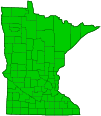common lambsquarters
(Chenopodium album)
Overview • Description • Distribution • Taxonomy
Overview |
|
|||||||
Common lambsquarters is an annual plant in the family Amaranthaceae. It is native to Europe, Asia, and North Africa. It has been widely cultivated as a grain, a leafy vegetable, and an animal feed. It readily escapes cultivation. It now occurs throughout the world on every continent except Antarctica, in every state in the United States, and in every province in Canada except Nunavut. It occurs in every county in Minnesota. |
||||||||
Common lambsquarters is considered a weed in some areas. It is fast growing and highly competitive, it tolerates a wide range of soil types and environmental conditions, and it is highly resistant to insect pests and disease. It can cause significant crop losses in corn, soybean, and sugar beet fields. |
||
Description |
||
Common lambsquarters is a fast-growing, annual forb. It rises on a single stem from a deep taproot and a shallow fibrous root system. It is usually 4″ to 59″ (10 to 150 cm) in height, rarely taller. It is erect at first but unless it has other plants to lean on it becomes recumbent due to the weight of the foliage and fruit. The stem is branched and green or red. The leaves are alternate. Lower stem leaves are triangular or diamond shaped, 1¼″ to 2¾″ (3 to 7 cm) long, and ¾″ to 2⅜″ (2 to 6 cm) wide. The margins are toothed or lobed. Upper stem leaves are lance-rhomboid shaped, ⅜″ to 2″ (1 to 5 cm) long, and ⅛″ to ¾″ (0.4 to 2.0 mm) wide. The upper surface is waxy, white mealy in appearance, and unwettable. The lower surface is whitish. The inflorescence is a short, dense spike of small flowers at the end of the stem and branches, and rising from upper leaf axils. The flowers are greenish-white and only about ⅛″ (2.5 mm) in diameter. There are 5 outer floral leaves (sepals), together called the calyx, no petals, 5 stamens, and 3 styles. The calyx is white mealy. The stamens have yellow anthers. The styles are short and are fused at the base, separated at the tip. The fruit is a small black seed contained in a thin, bladder-like, seed capsule called an utricle. |
||
Distribution |
||||
|
Sources |
|||
| 3/29/2023 | ||||
Taxonomy |
|||
| Kingdom | Plantae (green algae and land plants) | ||
| Subkingdom | Viridiplantae (green plants) | ||
| Infrakingdom | Streptophyta (land plants and green algae) | ||
| Superdivision | Embryophyta (land plants) | ||
| Division | Tracheophyta (vascular plants) | ||
| Subdivision | Spermatophytina (seed plants) | ||
| Class | Magnoliopsida (flowering plants) | ||
| Superorder | Caryophyllanae | ||
Order |
Caryophyllales (pinks, cactuses, and allies) | ||
Family |
Amaranthaceae (Amaranth) | ||
| Subfamily | Chenopodioideae | ||
| Tribe | Chenopodieae | ||
Genus |
Chenopodium (goosefoot) | ||
Subordinate Taxa |
|||
common lambsquarters (Chenopodium album var. boscianum) common lambsquarters (Chenopodium album var. centrorubrum) common lambsquarters (Chenopodium album ssp. iranicum) common lambsquarters (Chenopodium album var. microphyllum) common lambsquarters (Chenopodium album ssp. pseudostriatum) common lambsquarters (Chenopodium album var. reticulatum) late-flowering goosefoot (Chenopodium album var. striatum) Missouri lambsquarters (Chenopodium album var. missouriense) Stevens’ lambsquarters (Chenopodium album var. stevensii) white lambsquarters (Chenopodium album var. album) |
|||
Synonyms |
|||
Chenopodium acerifolium Chenopodium album ssp. album Chenopodium album var. album Chenopodium album var. candicans Chenopodium album var. centrorubrum Chenopodium album ssp. dacoticum Chenopodium album ssp. fallax Chenopodium album var. lanceolatum Chenopodium album var. missouriense Chenopodium album var. polymorphum Chenopodium album var. stevensii Chenopodium lanceolatum Chenopodium missouriense Chenopodium missouriense var. bushianum Chenopodium paganum Chenopodium suecicum |
|||
Common Names |
|||
common lamb’s-quarters common lambsquarters fat-hen giant fat-hen lamb’s-quarter lamb’s-quarters lambsquarters lambsquarters goosefoot white goosefoot |
|||
Glossary
Sepal
An outer floral leaf, usually green but sometimes colored, at the base of a flower.
Stamen
The male reproductive organ of a flower consisting of an pollen-producing anther on a supporting filament.
Visitor Photos |
|||||
Share your photo of this plant. |
|||||
| This button not working for you? Simply email us at info@MinnesotaSeasons.com. Attach one or more photos and, if you like, a caption. |
|||||
|
|||||
MinnesotaSeasons.com Photos |
|||||
|
|||||

Slideshows |
||

Visitor Videos |
|||
Share your video of this plant. |
|||
| This button not working for you? Simply email us at info@MinnesotaSeasons.com. Attach a video, a YouTube link, or a cloud storage link. |
|||
Other Videos |
|||

Visitor Sightings |
|||||
Report a sighting of this plant. |
|||||
| This button not working for you? Simply email us at info@MinnesotaSeasons.com. Be sure to include a location. |
|||||
|
|||||
MinnesotaSeasons.com Sightings |
|||||
Avon Hills Forest SNA, North Unit Badoura Jack Pine Woodland SNA Bertram Chain of Lakes Regional Park Blazing Star Prairie Addition Preserve, South Unit Charles A. Lindbergh State Park John Peter Hoffman Spring Brook Valley WMA Mound Spring Prairie SNA, North Unit Mound Spring Prairie SNA, South Unit Northern Tallgrass Prairie NWR, Hoffman Unit Prairie Creek WMA, Koester Prairie Unit Robert Ney Memorial Park Reserve |
|||||

Created: 3/24/2012
Last Updated:
